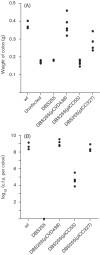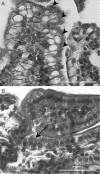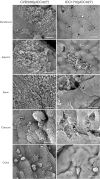Functional studies of intimin in vivo and ex vivo: implications for host specificity and tissue tropism
- PMID: 17379706
- PMCID: PMC2884948
- DOI: 10.1099/mic.0.2006/003467-0
Functional studies of intimin in vivo and ex vivo: implications for host specificity and tissue tropism
Abstract
Intimin is an outer-membrane adhesin that is essential for colonization of the host gastrointestinal tract by attaching and effacing pathogens including enteropathogenic Escherichia coli (EPEC), enterohaemorrhagic E. coli (EHEC) and Citrobacter rodentium (CR). The N-terminus of intimin from the different strains is highly conserved while the C-terminus, which harnesses the active receptor-binding site, shows sequence and antigenic polymorphism. This diversity was used to define a number of distinct intimin types, the most common of which are alpha, beta and gamma. Intimin binds the type III secretion system effector protein Tir. However, a large body of evidence suggests that intimin also binds a host-cell-encoded receptor(s) (Hir), and interaction of different intimin types with Hir contributes to tissue and host specificity. The aims of this study were to compare the activity of the major intimin types (alpha, beta and gamma) in vivo and ex vivo, using the CR mouse model and in vitro organ culture (IVOC), and to determine their exchangeability. The results confirm that intimin gamma is not functional in the CR mouse model. In the pig, intimin beta can substitute for EPEC intimin alpha but when placed in an EHEC O157 : H7 background it does not produce an intimin alpha-like tropism, although some adhesion to the small and large intestine was observed. In contrast, in human IVOC, intimin beta in an EHEC background produces small intestinal colonization in a similar manner to intimin alpha.
Figures








References
-
- Brooks, J. T., Sowers, E. G., Wells, J. G., Greene, K. D., Griffin, P. M., Hoekstra, R. M. & Strockbine, N. A. (2005). Non-O157 shiga toxin-producing Escherichia coli infections in the United States, 1983–2002. J Infect Dis 192, 1422–1429. - PubMed
-
- Chen, H. D. & Frankel, G. (2005). Enteropathogenic Escherichia coli: unravelling pathogenesis. FEMS Microbiol Rev 29, 83–98. - PubMed
-
- Deng, W., Vallance, B. A., Li, Y., Puente, J. L. & Finlay, B. B. (2003). Citrobacter rodentium translocated intimin receptor (Tir) is an essential virulence factor needed for actin condensation, intestinal colonization and colonic hyperplasia in mice. Mol Microbiol 48, 95–115. - PubMed
Publication types
MeSH terms
Substances
Grants and funding
LinkOut - more resources
Full Text Sources

